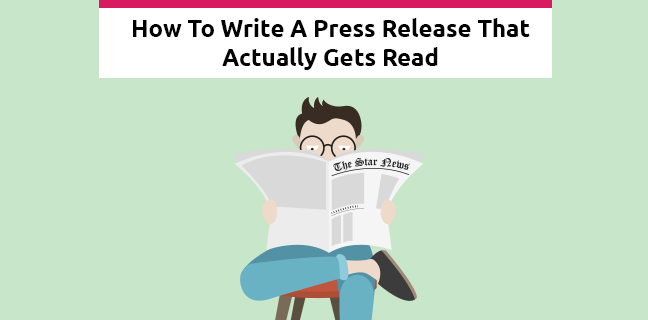Table of Content
No headings found.
A blog post and a press release are two very different things.
It used to be that when something wasn’t newsworthy enough to send to media outlets, you’d just slap the news on a blog post. However, things no longer work the same nowadays.
If businesses were to post corporate announcements on their blogs, it is often so uninteresting to readers that it can hurt their engagement cycle.
At the same time, if you were to pass off a long-winded general help article as a press release, it can fail to attract journalists skimming for important news.
The trend is, many are dropping press releases arguing that blog posts can bring a larger impact from being evergreen and its relevance to reach the right targeted audience.
However rather than choosing blog posts over press release, in today’s world of consumer-driven content, a business needs both to keep the conversation going with their target audiences.
Before we go into the why and what are the differences between the two, let’s begin with some definitions. A bit dry, I admit, but it's a must-have.
What is a Blog Post?
Well, this writing that you are reading to understand the contrast between a press release a blog post is basically an entry of a blog.
Blog posts can vary in purpose, like this being educational or even at times entertaining. Think Mummy Buzzfeed.
But often it contains detailed information about a subject matter weaved with personal opinions and ending with the author inviting the readers to interact by leaving comments on a post.

What is a Press Release?
A press release, on the other hand, is a company written announcement to the media about their latest updates.
It can be about scheduled events, promotions, awards, new products and services, or any newsworthy updates.
If you're looking for some inspiration on what kind of content to include in a press release, we've put together a collection of the best press release examples for various occasions.
However, you don't necessary send a press release only when there's something new, many businesses also use this as a method of promotion or to establish authority.
The Difference?
Essentially, both press release and blog posts are content but they serve different expectations.
Blog readers are looking for lists, summaries and at times actionable content, while press release readers are looking for information on your company. Thus, both play important roles in your PR efforts - building the brand for your company.
Imagine the press release to be your trusted, formal spokesman for the company, while your blog is the human face for your company, providing readers with tips and pieces of advice.
Both types of content are important to craft different messages to different audiences. Then the question becomes, when do you use what?
Of course, you can write your company announcement in a blog post or share tips through a press release, but when do you use what?
The question is not just about what you are trying to convey but rather ask yourself:
Do you want this on the news? Then use a press release. Or if you want to send a piece of news from your perspective, it would be better on a blog.
Besides expectations, what separates press releases and blog posts are also in terms of format and writing. Here are 4 differences between these two types of content:
1. News vs Information
Press releases share official company “news.” The way you deliver that is typically pretty conservative. The messaging is formal, tight, and controlled. Think of it as an email to your boss versus your buddy. You’re probably going to relay the details a bit differently.
Besides, a press release is objective and factual, on top of being as complete as possible. Keep your content focused on facts that cover the 5Ws - Who, What, Where, When, and Why.
The goal is to present the most relevant information so that reader can understand more about your new announcement or event as well as your business. Press release readers are always skimming, so it's best to present your most important announcement first.

On the other hand, blogs are highly personal. They reflect the blogger’s unique experience and strive to connect directly with the reader. It’s like a conversation between close friends. You pretty much say it like you see it.
Unlike press release that stick to the facts, there's no restriction to blog posts. It can be a sharing about your experience, your personal opinions on the latest political events, a diary for your baby, really just anything!
But for businesses, blog posts are often more educational, it offers tips and tricks that teaches readers more about their industry.
Whether it is how to do your contouring right or 5 tips to a better blog post - the best ones do it in a way that educates their readers by sharing insight, and
not just hard selling their products or services.
Of course, businesses also use it to express their opinions, which you can bet there’ll be those who both share and oppose them. And that’s great because your blog post should foster engagement and build followers.
2. Formal vs Conversational

Like how I’m speaking to you, blog posts assume the first and second person tone to make it conversational and relatable. It’s personal as we express our opinions, so go ahead and use I, you, or our to make it an engaging piece.
It's however not a 'me or we' when it comes to the press release, it’s the company. You’re representing your company when writing your news, so structure your messaging in a neutral way that will explain things objectively from an outsider looking in perspective.
3. Reporters vs Readers
You've got to know who you're speaking to when you're writing. The same applies for press release and blog posts.
For press releases, remember that you are writing for the general audience and journalists in particular.
Journalists write in AP Style. Learn it. Use it. When you make the effort to conform to their standards, it increases your credibility and can improve your standing with this highly influential audience.
Blog posts on the other hand, is more generally geared to your followers, your readers and fans who follow your stuff. So understand who you're writing to and speak in their language.
4. Long vs Short
Not just word count of 400 words vs 2000 words, the biggest difference between the two might be the production time, press releases require less investment in terms of production time.
Blog posts are generally more comprehensive and aimed to cover all aspects of the subject matter. This word count is also important to cater the writing for search engine optimization, to cover the keywords and increase visitor engagement time on the post.
Meanwhile, press releases are focused on relaying the important message and announcement, thus it needs to be kept short and simple. Straight to the point.
Besides, journalists are looking through thousands of press releases every day, so it is important to highlight your information in the headline itself, and the content exist to support it.
Best results with both Press Release and Blog Post
It’s all about determining the right balance between public relations and content marketing for your organization’s goal.
To start, you need to toss out your press release vs blog post line of thinking and start planning for how you can use both to bring in results.
Because it might strike to you that the same elements which make up a good press release would actually make for a poor vlog post.
Press releases and blogs are but two of many communications tools comprising your content arsenal. Leverage all of them. But be purposeful about it. After all you wouldn’t grab a putter and head to the tee box. Consider your audience, know how they like to receive information and then deliver!
However don’t mistake this, your press release should be engaging as well because in the 21st century, it’s rare to find an audience that will engage with content that isn’t enjoyable to read,
Whether you’re writing a press release or blog post—literally any word that you arrange for a business purpose—it has to be interesting.
So where do you stand in the battle of press release vs. blog?
Free Press Release Template
Tell us where to send your PDF:







